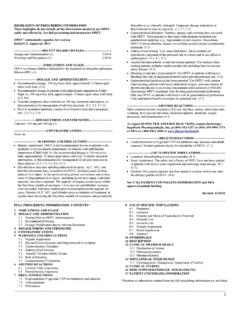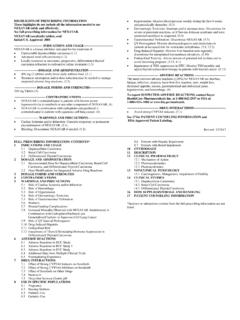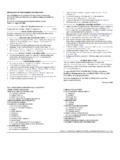Transcription of HIGHLIGHTS OF PRESCRIBING INFORMATION These …
1 1 HIGHLIGHTS OF PRESCRIBING INFORMATION These HIGHLIGHTS do not include all the INFORMATION needed to use CIMZIA safely and effectively. See full PRESCRIBING INFORMATION for CIMZIA. CIMZIA (certolizumab pegol) for injection, for subcutaneous use CIMZIA (certolizumab pegol) injection, for subcutaneous use Initial Approval: 2008 WARNING: SERIOUS INFECTIONS AND MALIGNANCY See full PRESCRIBING INFORMATION for complete boxed warning. o Increased risk of serious infections leading to hospitalization or death including tuberculosis (TB), bacterial sepsis, invasive fungal infections (such as histoplasmosis), and infections due to other opportunistic pathogens ( ). o CIMZIA should be discontinued if a patient develops a serious infection or sepsis ( ).
2 O Perform test for latent TB; if positive, start treatment for TB prior to starting CIMZIA ( ). o Monitor all patients for active TB during treatment, even if initial latent TB test is negative ( ) o Lymphoma and other malignancies, some fatal, have been reported in children and adolescent patients treated with TNF blockers, of which CIMZIA is a member ( ). CIMZIA is not indicated for use in pediatric patients. ( ) ----------------------------RECENT MAJOR CHANGES-------------------------- Indications and Usage ( ) 03/2019 Dosage and Administration ( ) 03/2019 Dosage and Administration ( ) 02/2019 Warnings and Precautions ( ) 02/2019 ----------------------------INDICATIONS AND USAGE--------------------------- CIMZIA is a tumor necrosis factor (TNF) blocker indicated for.
3 Reducing signs and symptoms of Crohn s disease and maintaining clinical response in adult patients with moderately to severely active disease who have had an inadequate response to conventional therapy ( ) Treatment of adults with moderately to severely active rheumatoid arthritis ( ) Treatment of adult patients with active psoriatic arthritis. ( ) Treatment of adults with active ankylosing spondylitis ( ) Treatment of adults with active non-radiographic axial spondyloarthritis with objective signs of inflammation ( ) Treatment of adults with moderate-to-severe plaque psoriasis who are candidates for systemic therapy or phototherapy ( ) -----------------------DOSAGE AND ADMINISTRATION----------------------- CIMZIA is administered by subcutaneous injection.
4 The recommended initial dose of CIMZIA is 400 mg (given as two subcutaneous injections of 200 mg) (2). Crohn s Disease ( ) 400 mg initially and at Weeks 2 and 4. If response occurs, follow with 400 mg every four weeks Rheumatoid Arthritis ( ) 400 mg initially and at Weeks 2 and 4, followed by 200 mg every other week; for maintenance dosing, 400 mg every 4 weeks can be considered Psoriatic Arthritis ( ) 400 mg initially and at week 2 and 4, followed by 200 mg every other week; for maintenance dosing, 400 mg every 4 weeks can be considered. Ankylosing Spondylitis ( ) 400 mg (given as 2 subcutaneous injections of 200 mg each) initially and at weeks 2 and 4, followed by 200 mg every other week or 400 mg every 4 weeks. Non-radiographic Axial Spondyloarthritis ( ) 400 mg (given as 2 subcutaneous injections of 200 mg each) initially and at weeks 2 and 4, followed by 200 mg every other week or 400 mg every 4 weeks.
5 Plaque Psoriasis ( , ) 400 mg (given as 2 subcutaneous injections of 200 mg each) every other week. For some patients (with body weight 90 kg), a dose of 400 mg (given as 2 subcutaneous injections of 200 mg each) initially and at Weeks 2 and 4, followed by 200 mg every other week may be considered. ----------------------DOSAGE FORMS AND STRENGTHS--------------------- For injection: 200 mg lyophilized powder in a single-dose vial (3) Injection: 200 mg/mL solution in a single-dose prefilled syringe (3) ------------------------------CONTRAINDI CATIONS------------------------------- Serious hypersensitivity reaction to certolizumab pegol or to any of the excipients. (4) ------------------------WARNINGS AND PRECAUTIONS----------------------- Serious Infections: CIMZIA should not be initiated in patients with an active infection.
6 Monitor for infection during and after treatment; discontinue if a serious infection develops. If invasive fungal infection develops in patients who reside or travel to regions where mycoses are endemic, consider empiric antifungal therapy. ( ) Malignancies: Cases of lymphoma and other malignancies have been observed among patients receiving TNF blockers, including CIMZIA. ( ) Heart Failure: Monitor patients for new onset or worsening congestive heart failure. ( ) Hypersensitivity Reactions: Discontinue CIMZIA and institute appropriate therapy if anaphylaxis or other serious hypersensitivity reactions occur. ( ) Hepatitis B Virus Reactivation: Test for HBV infection before starting CIMZIA. Monitor HBV carriers during and several months after therapy.
7 If reactivation occurs, stop CIMZIA and begin anti-viral therapy ( ) Neurologic Reactions: Exacerbation or new onset demyelinating disease may occur; use caution in patients with pre-existing or recent-onset demyelinating disorders. ( ) Hematological Reactions (including leukopenia, pancytopenia and thrombocytopenia): Use with caution in patients who have ongoing, or a history of, significant hematologic abnormalities. Advise patients to seek immediate medical attention if symptoms develop; consider discontinuing CIMZIA in patients with confirmed abnormalities. ( ) Use with Anakinra, Abatacept, Rituximab and Natalizumab: Increased risk of serious infections; concomitant use is not recommended. ( , ) Autoimmunity: Discontinue CIMZIA if lupus-like syndrome develops.
8 ( ) Live vaccines: Avoid use with CIMZIA ( , ) ------------------------------ADVERSE REACTIONS------------------------------ Most common adverse reactions ( 7%): upper respiratory tract infection, rash, and urinary tract infection ( ) To report SUSPECTED ADVERSE REACTIONS, contact UCB, Inc. at 1-866-822-0068 or FDA at 1-800-FDA-1088 or ------------------------------DRUG INTERACTIONS---------------------------- -- Laboratory Tests: May cause erroneously elevated aPTT results. ( ) See 17 for PATIENT COUNSELING INFORMATION and Medication Guide. Revised: 09/2019 2 full PRESCRIBING INFORMATION : CONTENTS* WARNING: SERIOUS INFECTIONS AND MALIGNANCY 1 INDICATIONS AND USAGE Crohn s Disease Rheumatoid Arthritis Psoriatic Arthritis Ankylosing Spondylitis Non-radiographic Axial Spondyloarthritis Plaque Psoriasis 2 DOSAGE AND ADMINISTRATION Crohn s Disease Rheumatoid Arthritis Psoriatic Arthritis Ankylosing Spondylitis Non-radiographic Axial Spondyloarthritis Plaque Psoriasis Preparation and Administration of CIMZIA Using the Lyophilized Powder for Injection Preparation and Administration of CIMZIA Using the Prefilled Syringe Monitoring to Assess Safety Concomitant Medications 3 DOSAGE FORMS AND STRENGTHS 4 CONTRAINDICATIONS 5 WARNINGS AND PRECAUTIONS Risk of Serious Infections Malignancies Heart
9 Failure Hypersensitivity Reactions Hepatitis B Virus Reactivation Neurologic Reactions Hematological Reactions Use with Biological Disease-Modifying Antirheumatic Drugs (Biological DMARDs) Autoimmunity Immunizations Immunosuppression 6 ADVERSE REACTIONS Clinical Trials Experience Immunogenicity Postmarketing Experience 7 DRUG INTERACTIONS Use with Anakinra, Abatacept, Rituximab and Natalizumab Live Vaccines Laboratory Tests 8 USE IN SPECIFIC POPULATIONS Pregnancy Lactation Pediatric Use Geriatric Use 10 OVERDOSAGE 11 DESCRIPTION 12 CLINICAL PHARMACOLOGY Mechanism of Action Pharmacodynamics Pharmacokinetics 13 NONCLINICAL TOXICOLOGY Carcinogenesis, Mutagenesis, and Impairment of Fertility 14 CLINICAL STUDIES Crohn s Disease Rheumatoid Arthritis Psoriatic Arthritis Ankylosing Spondylitis Non-radiographic Axial Spondyloarthritis Plaque Psoriasis 15 REFERENCES 16 HOW SUPPLIED/STORAGE AND HANDLING 17 PATIENT COUNSELING INFORMATION *Sections or subsections omitted from the full PRESCRIBING INFORMATION are not 3 full PRESCRIBING INFORMATION WARNING: SERIOUS INFECTIONS AND MALIGNANCY SERIOUS INFECTIONS Patients treated with CIMZIA are at increased risk for developing serious infections that may lead to hospitalization or death [see Warnings and Precautions ( ) and Adverse Reactions ( )].
10 Most patients who developed These infections were taking concomitant immunosuppressants such as methotrexate or corticosteroids. CIMZIA should be discontinued if a patient develops a serious infection or sepsis. Reported infections include: Active tuberculosis, including reactivation of latent tuberculosis. Patients with tuberculosis have frequently presented with disseminated or extrapulmonary disease. Patients should be tested for latent tuberculosis before CIMZIA use and during therapy. Treatment for latent infection should be initiated prior to CIMZIA use. Invasive fungal infections, including histoplasmosis, coccidioidomycosis, candidiasis, aspergillosis, blastomycosis, and pneumocystosis. Patients with histoplasmosis or other invasive fungal infections may present with disseminated, rather than localized disease.







